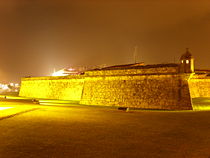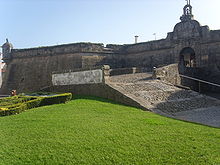
Nossa Senhora da Conceição Fortress
Encyclopedia


Portugal
Portugal , officially the Portuguese Republic is a country situated in southwestern Europe on the Iberian Peninsula. Portugal is the westernmost country of Europe, and is bordered by the Atlantic Ocean to the West and South and by Spain to the North and East. The Atlantic archipelagos of the...
fortress in Póvoa de Varzim
Póvoa de Varzim
Póvoa de Varzim is a Portuguese city in the Norte Region and sub-region of Greater Porto, with a 2011 estimated population of 63,364. According to the 2001 census, there were 63,470 inhabitants with 42,396 living in the city proper. The urban area expanded, southwards, to Vila do Conde, and there...
rebuilt during the reigns of Peter II and John V (between 1701 and 1740) to defend the town from privateer
Privateer
A privateer is a private person or ship authorized by a government by letters of marque to attack foreign shipping during wartime. Privateering was a way of mobilizing armed ships and sailors without having to spend public money or commit naval officers...
s, in the site of an earlier fort known as "Forte de Torrão". It is considered a listed property of Public Interest in Portugal.
The early fort
Pinho Leal, in the book Portugal Antigo e Moderno (1876) stated that it is supposed that a small and ancient fort, called Forte de Torrão, was built in the 1400s, during the reign of John I of PortugalJohn I of Portugal
John I KG , called the Good or of Happy Memory, more rarely and outside Portugal the Bastard, was the tenth King of Portugal and the Algarve and the first to use the title Lord of Ceuta...
. In the end of the 16th century, the shipbuilding industry started developing in the area of Ribeira, located around Forte de Torrão fort.
The fortification was financed by the town hall, and had as main goal to protect the growing fisher community from privateers. This early fort, that still existed in 1685, was garnished by a lieutenant, a condestável and two artillerymen, nominated by the town hall.
The 18th century fortress
In the end of the 17th century, with the urge for a better defense of the seaport, the alcaide (governor of the fort) João de Almeira Rêgo thought that the construction of a new fortress would be preferable.Construction began in 1701, during the reign of Peter II of Portugal, with an architectural project by the sergeant major and engineer Sebastião de Souza. Works halted in 1703 due to lack of funding. Several year later, John V of Portugal, unaware of the situation, was informed that the seaport of Póvoa de Varzim had no security due to the stop of the construction works in the fortification for several years.
Works resumed in 1738 when Sir Diogo de Sousa, sun of Sir João de Sousa, Governor of Arms of Minho province, received orders from the king to complete the fortress. These order were dispatched due to the fact that the king considered that this coastal fortification was of great importance for the kingdom. As Sir Diogo de Sousa was the governor to complete the fortress in 1740, his family crest were placed over the gate on October 22nd of that year, precisely on the day of the monarch's anniversary.

